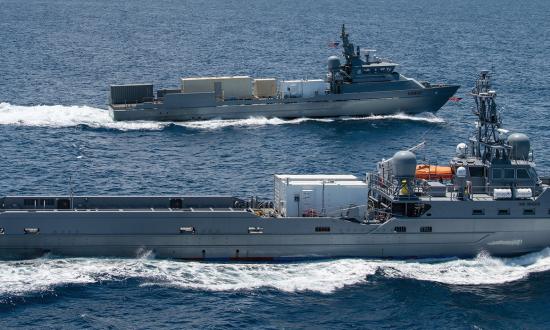In early June, the Navy took delivery of LCAC-104. This newest ship-to-shore connector (SSC) is an extensively redesigned variant of the long-serving air-cushioned landing craft that have transported Marine vehicles, provisions, and personnel from amphibious ships to the beach since 1987. Textron Systems, longtime builder of the landing craft, air cushion (LCAC), is also building units 105–16.
The Navy and Marine Corps have long considered the LCAC a critical cog in the Sea Services’ amphibious warfare machine. To skim the sea and glide across the beach, the LCACs use air-cushion technology that dates to a 1962 Navy “Hydroskimmer” vessel, the largest U.S. air-cushion craft ever built. In 1965, the Navy acquired two SK-5 air-cushion vessels, developed by Bell Aerosystems, for training personnel on Lake Erie. The Army used the SK-5 for riverine operations in Vietnam.
In early 1995, the Navy funded a mid-life availability program for its LCACs. Congress approved $57 million for a formal service-life extension program (SLEP) for 74 of the craft in 1996. The SLEP funding was incorporated into standing Textron production contracts to encompass system modifications and upgrades needed to add 10 years to the original 20-year service life. The Navy subsequently decided to seek significant design upgrades through the next-generation SSC initiative.
In July 2012, the Navy awarded Textron a contract for detailed design and construction of an SSC test-and-training craft and up to eight production craft. The company is teamed for the SSC program with L-3 Harris, which is providing advanced maritime integration capability, and with Alcoa for the SSC aluminum structure.
To support design work, Textron invested $45 million of company funds in its New Orleans production facility. In April 2020, the Navy awarded the company a follow-on SSC production contract for a total of 24 units.
The new 92-foot-long SSCs, displacing 180 metric tons, will provide 1,603 square feet of deck area (about 67 by 24 feet) to accommodate a 74-ton payload of vehicles, ammunition, and other stores, compared to 60 tons for the older LCACs. The SSCs also can be fitted with an enclosed personnel module that can accommodate 145 fully equipped Marines. The SSC is 26 feet tall with a 48-foot beam.
The craft are powered by four Rolls Royce MT-7 gas turbine engines, the same engine used by the MV-22 Osprey tiltrotor transport aircraft. Each engine can generate 7,000 shaft horsepower, giving the craft a maximum speed of 35 knots in sea state 3. The MT-7s are controlled by a full-authority digital electronic control system (FADEC) that drives six-bladed propellers. The craft are equipped with two bow thrusters for maneuver control.
SSCs are fitted out with a 56-inch-deep skirt designed to reduce drag and weight; the current craft have a 50-inch skirt. The hull is built from Alcoa’s corrosion-resistant aluminum. The propeller shroud assemblies and shafts are fabricated from high-strength composites that offer improved reliability and, the Navy hopes, lower life-cycle maintenance costs.
While the Marine Corps currently is debating the role of the tank in its combat inventory, the SSC was designed, like the fielded LCACs, to accommodate the M1A1 Abrams main battle tank.
The SSC is crewed by a pilot, copilot, loadmaster, and deck engineer. Like the fielded LCACs, the new SSCs will be able to deploy from all the Navy’s well-deck amphibious ships. The Navy believes the craft will be able to land on about 80 percent of the world’s coasts. Textron says that, like all the fielded LCACs, the SSCs will be fully capable of supporting humanitarian and disaster-relief operations.






